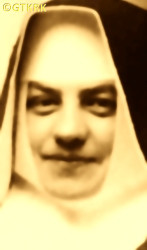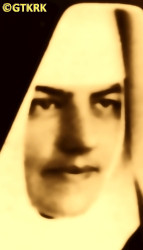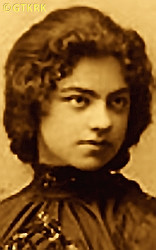Roman Catholic
St Sigismund parish
05-507 Słomczyn
85 Wiślana Str.
Konstancin deanery
Warsaw archdiocese, Poland
full list:
displayClick to display full list

searchClick to search full list by categories
wyświetlKliknij by wyświetlić pełną listę po polsku

szukajKliknij by przeszukać listę wg kategorii po polsku

Martyrology of the clergy — Poland
XX century (1914 – 1989)
personal data
religious status
Servant of God
surname
TEODOROWICZ-POLIAŃSKA
forename(s)
Mary (pl. Maria)
religious forename(s)
Monica (pl. Monika)

function
nun
creed
Ukrainian Greek Catholic GCmore on
en.wikipedia.org
[access: 2013.05.19]
congregation
Basilian Order Sisters of Saint Josaphat OSBMmore on
en.wikipedia.org
[access: 2014.09.21]
(i.e. Basilian Sisters)
nationality
Ukrainian
date and place
of death
26.12.1951

ITL DubravLagGuLAG slave labour camp network
today: Yavas, Mordovia rep., Russia
more on
en.wikipedia.org
[access: 2022.01.09]
en.wikipedia.org
[access: 2022.01.06]
alt. dates and places
of death
25.12.1951
Partsatoday: Yavas, Zubova Polyana reg., Mordovia rep., Russia
more on
ru.wikipedia.org
[access: 2022.08.05]
details of death
After end of military hostilities of the World War II, started by German and Russian invasion of Poland in 09.1939, after start of another Russian occupation in 1944, arrested by Russian genocidal NKVD on 27.11.1945.
Jailed in Stanislaviv prison. During the first six months of imprisonment, underwent 25, hours long, interrogations. Held in a cell with water dripped from the ceiling.
On 21.06.1947 sentenced to 8 years in slave labour concentration camps Gulag.
Deported to ITL DubravLag slave labour camp in Mordova republic, where perished.
Buried in an unknown spot, prob. in the cemetery in the village of Parca, c. 5 km south, along the railway line, from the center of the camp in the village of Yavas (till today two corrective colonies, IK13 and IK 14, exist in the village).
cause of death
extermination
perpetrators
Russians
sites and events
ITL DubravLagClick to display the description, OsobLagsClick to display the description, GulagClick to display the description, StanislavivClick to display the description
date and place
of birth
28.05.1885

Ivanykivkatoday: Bohorodchany hrom., Stanislaviv/Ivano‐Frankivsk rai., Stanislaviv/Ivano‐Frankivsk obl., Ukraine
more on
uk.wikipedia.org
[access: 2022.08.05]
parents
TEODOROWICZ Nicholas
🞲 ?, ? — 🕆 ?, ?

OCHRYMOWICZ Charitina
🞲 ?, ? — 🕆 ?, ?
positions held
1930 – 1945
superior — Pidmykhailivtsitoday: Rohatyn urban hrom., Stanislaviv/Ivano‐Frankivsk rai., Stanislaviv/Ivano‐Frankivsk obl., Ukraine
more on
uk.wikipedia.org
[access: 2023.03.02] ⋄ Basilian Sisters OSBM ⋄ GC monastery — with a short break in 1933, when decided to live in isolation, but at the request of Fr Clement Casimir Mary Szeptycki, resumed her function as superior
1927 – 1930
superior — Zhuravnetoday: Zhuravne hrom., Stryi rai., Lviv obl., Ukraine
more on
en.wikipedia.org
[access: 2022.04.17] ⋄ Basilian Sisters OSBM ⋄ GC monastery
1917 – 1927
superior — Slovitatoday: Hlyniany urban hrom., Lviv rai., Lviv obl., Ukraine
more on
uk.wikipedia.org
[access: 2023.03.02] ⋄ Basilian Sisters OSBM ⋄ GC monastery
till 1927
nun — Slovitatoday: Hlyniany urban hrom., Lviv rai., Lviv obl., Ukraine
more on
uk.wikipedia.org
[access: 2023.03.02] ⋄ Basilian Sisters OSBM ⋄ GC monastery
widow — 1904‐1908 wife of Ambrose Polyansky
others related
in death
CEHELSKIClick to display biography Nicholas Sava Josaphat, CIELISZCZUKClick to display biography Dennis, CZECHOWSKIClick to display biography Steven, DAWIDZIUKClick to display biography Theodore, HORCZYŃSKIClick to display biography Omelian, MARUSZCZAKClick to display biography Vladimir, OCZABRUKClick to display biography Emilian, ŻUKClick to display biography Michael, TEODOROWICZClick to display biography Peter (Fr Paul)
sites and events
descriptions
ITL DubravLag: Russian Rus. Исправи́тельно‐Трудово́й Ла́герь (Eng. Corrective Labor Camp) ITL Rus. Дубравный (Eng. Dubravniy) — concentration and slave forced labor camp (within the Gulag complex) — headquartered in Yavas in Republic of Mordovia. Founded on 28.02.1948, in place of ITL TemLag camp, and until 1954 also functioning as the Rus. Особый лагерь (Eng. Special camp) GULAG No. 3. Prisoners slaved at operating the Temnykovskiy industrial complex built by ITL TemLag prisoners: sewing factories, woodworking plants (e.g. furniture production), factories producing building materials (bricks, tiles, lime, building stone), railway lines, energy plants, peat extraction, wood chemical plants, etc. At its peak — till the death on 05.03.1953 of Russian socialist leader, Joseph Stalin — c. 26,000 prisoners were held there: e.g. 23,273 (01.01.1949); 23,532 (01.01.1950); 23,541 (01.01.1951); 25,616 (01.01.1952); 20,680 (01.01.1953); 16,980 (01.01.1954). Formally closed its operations in 1960, but political prisoners were held there for many years later — among them Ukrainian priests and Russian dissidents — until its final closure in the second half of the 1980s. (more on: old.memo.ruClick to attempt to display webpage
[access: 2024.04.08], archive.khpg.orgClick to attempt to display webpage
[access: 2014.09.21])
OsobLags: Pursuant to Decree No. 416‐159сс dated 21.02.1948 of the Russian government, the Russian criminal organization MVD (successor to the NKVD) issued a Decree No. 00219 of 28.02.1948 establishing a separate network of camps within the Gulag system for a „special group” of political prisoners sentenced under Art. 58 of the Penal Code (referring to „enemies of the people”, i.e. accused of treason, espionage, terrorism, etc.) Initially, the group of camps included the ITL MinLag, ITL GorLag, ITL DubravLag, ITL StepLag and ITL BerLag concentration camps. Later, the following ones were added: ITL RechLag, ITL OzerLag, ITL PeschanŁag, ITL LugLag, ITL Kamyshlag, ITL DalLag, ITL VodorazDelLag. After the death of the Russian socialist leader, Joseph Stalin, in 1953, the three largest revolts in the history of the Gulag took place there: the Norilsk Uprising, the Vorkuta Uprising and the Kengir Uprising. In c. 1954 the camps were converted into standard correctional camps. (more on: en.wikipedia.orgClick to attempt to display webpage
[access: 2024.01.26])
Gulag: The acronym Gulag comes from the Rus. Главное управление исправительно‐трудовых лагерей и колоний (Eng. Main Board of Correctional Labor Camps). The network of Russian concentration camps for slave labor was formally established by the decision of the highest Russian authorities on 27.06.1929. Control was taken over by the OGPU, the predecessor of the genocidal NKVD (from 1934) and the MGB (from 1946). Individual gulags (camps) were often established in remote, sparsely populated areas, where industrial or transport facilities important for the Russian state were built. They were modeled on the first „great construction of communism”, the White Sea‐Baltic Canal (1931‐1932), and Naftali Frenkel, of Jewish origin, is considered the creator of the system of using forced slave labor within the Gulag. He went down in history as the author of the principle „We have to squeeze everything out of the prisoner in the first three months — then nothing is there for us”. He was to be the creator, according to Alexander Solzhenitsyn, of the so‐called „Boiler system”, i.e. the dependence of food rations on working out a certain percentage of the norm. The term ZEK — prisoner — i.e. Rus. заключенный‐каналоармец (Eng. canal soldier) — was coined in the ITL BelBaltLag managed by him, and was adopted to mean a prisoner in Russian slave labor camps. Up to 12 mln prisoners were held in Gulag camps at one time, i.e. c. 5% of Russia's population. In his book „The Gulag Archipelago”, Solzhenitsyn estimated that c. 60 mln people were killed in the Gulag until 1956. Formally dissolved on 20.01.1960. (more on: en.wikipedia.orgClick to attempt to display webpage
[access: 2024.04.08])
Stanislaviv: Prison used by the Russians (in 1939‐1941 — in 06.1941, when escaping from advancing Germans, Russians perpetrated a mass murder on prison inmates — and from 1944); the Germans (in 1941‐1944); and again by the Russian occupiers after replacing Germans in 1944. Thousands of Poles were jailed there. (more on: stanislawow.netClick to attempt to display webpage
[access: 2014.01.06], stanislawow.netClick to attempt to display webpage
[access: 2014.01.06])
sources
personal:
www.ugcc.org.uaClick to attempt to display webpage
[access: 2014.09.21], www.bazylianie.plClick to attempt to display webpage
[access: 2014.09.21], magazine.lds.lviv.uaClick to attempt to display webpage
[access: 2014.03.21]
original images:
newsaints.faithweb.comClick to attempt to display webpage
[access: 2014.03.21], newsaints.faithweb.comClick to attempt to display webpage
[access: 2014.03.21], risu.uaClick to attempt to display webpage
[access: 2022.08.05]
LETTER to CUSTODIAN/ADMINISTRATOR
If you have an Email client on your communicator/computer — such as Mozilla Thunderbird, Windows Mail or Microsoft Outlook, described at WikipediaPatrz:
en.wikipedia.org, among others — try the link below, please:
LETTER to CUSTODIAN/ADMINISTRATORClick and try to call your own Email client
If however you do not run such a client or the above link is not active please send an email to the Custodian/Administrator using your account — in your customary email/correspondence engine — at the following address:

giving the following as the subject:
MARTYROLOGY: TEODOROWICZ-POLIAŃSKA Mary
To return to the biography press below:
 Click to return to biography
Click to return to biography










